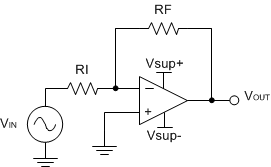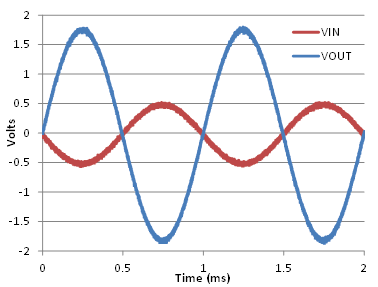SLOS013C March 1987 – March 2016 LF347 , LF347B
PRODUCTION DATA.
- 1 Features
- 2 Applications
- 3 Description
- 4 Revision History
- 5 Pin Configuration and Functions
- 6 Specifications
- 7 Parameter Measurement Information
- 8 Detailed Description
- 9 Application and Implementation
- 10Power Supply Recommendations
- 11Layout
- 12Device and Documentation Support
- 13Mechanical, Packaging, and Orderable Information
封装选项
请参考 PDF 数据表获取器件具体的封装图。
机械数据 (封装 | 引脚)
- D|14
- N|14
散热焊盘机械数据 (封装 | 引脚)
订购信息
9 Application and Implementation
NOTE
Information in the following applications sections is not part of the TI component specification, and TI does not warrant its accuracy or completeness. TI’s customers are responsible for determining suitability of components for their purposes. Customers should validate and test their design implementation to confirm system functionality.
9.1 Application Information
The LF347 has four independent amplifiers that have very low input bias current which allow using higher resistance resistors in the feedback network. The upper input common mode range typically goes to the positive supply rail. The lower common mode range does not include the negative supply rail; it must be at least 4-V greater. Output resistance is 200 Ω to protect the device from accidental shorts.
9.2 Typical Application
A typical application for an operational amplifier is an inverting amplifier. This amplifier takes a positive voltage on the input, and makes it a negative voltage of the same magnitude. In the same manner, it also makes negative voltages positive.
 Figure 6. Inverting Amplifier
Figure 6. Inverting Amplifier
9.2.1 Design Requirements
The supply voltage must be chosen such that it is larger than the input voltage range and output range. For instance, this application scales a signal of ±0.5 V to ±1.8 V. Setting the supply at ±12 V is sufficient to accommodate this application.
9.2.2 Detailed Design Procedure
Determine the gain required by the inverting amplifier:


When the desired gain is determined, choose a value for RI or RF. Choosing a value in the kΩ range is desirable because the amplifier circuit uses currents in the milliamp range. This ensures the part does not draw too much current. For this example, choose 10 kΩ for RI which means 36 kΩ is used for R, as determined by Equation 3.

9.2.3 Application Curve
 Figure 7. Input and Output Voltages of the Inverting Amplifier
Figure 7. Input and Output Voltages of the Inverting Amplifier